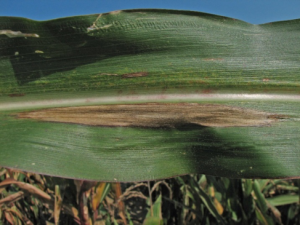Ken Wise, NYS IPM-Cornell University
Joe Lawrence, PRO-DAIRY-Cornell University
The current 2017 wet/rainy weather and high humidity can create a situation where diseases can become an issue in corn. While there are several foliar diseases that can occur on corn under these conditions, gray leaf spot and northern corn leaf blight have been especially problematic over the last several years. Gray leaf spot and northern corn leaf blight can cause yield losses and the risk of infection may be an issue this year. What should a grower do about it? While applying protective fungicides is an option, there are several things to consider before spraying. Here are a few steps to follow when making a decision.
- Scout fields for the gray leaf spot and northern corn leaf blight at tasseling. If there are lesions on leaves at or above the corn ear exceeding 5% of the plant leaf area consider a fungicide. If lesions develop later after tasseling, then economic benefits from using a fungicide will be less.
- Does your hybrid have at least moderate resistance? This can make a big difference in yield and likely will not require a fungicide application. Disease symptoms may be present in resistant corn, but a fungicide most likely will not increase yield.
- Crop rotation and tillage is an effective method to control the fungi. The longer the rotation the less inoculum will be on the surface. If you maintain no-tillage, zone-tillage or reduced tillage rotating away from corn for 2 years can help reduce pathogen populations.
- Fungicides can be very effective when disease exists above the economic threshold. However, fungicides are protective not curative, so applications need to be made before the full extent of disease damage is known. It is generally not economical to spray fungicide on silage corn.
Identification

Early symptoms are yellow to tan lesions with a faint watery halo. As the lesion progresses, it turns brown and is rectangular in shape, between the veins. When fully developed the lesion can be 3 to 4 inches long and a 1/6 to 1/8 inch wide. The fungus can overwinter on corn debris left on the soil surface. Sporulation occurs during warm and humid weather in late spring. The spores can be transmitted by both wind and rain. In some cases gray leaf spot can reduce corn yields from 5 to 40 bushels per acre.

The symptoms are long, cigar-shaped lesions that are about a 1/8 to ¼ inch wide. The lesions can be many inches long. Lesions are grayish-tan and have a pigmented border. There are numerous races of the pathogen, some of which overcome resistance genes deployed in many of the corn varieties grown in NY. The fungus overwinters on corn crop residue from previous years.
Other foliar diseases of corn to look out for this season
- Northern Corn Leaf Spot (Cochliobolus carbonum)
- Eyespot (Aureobasidium zeae)
- Common Rust (Puccinia sorghi)
- Anthracnose (Colletotrichum graminicola)
Plant Health
Certain fungicides now carry a label for plant health benefits when used at the V4-5 stage and, if warranted, again at tasseling. Product labels suggest potential yield and quality benefits from their use. Cornell University is conducting field evaluations to better understand the economic returns of using fungicides in this manner.
Forage Quality
There are numerous factors affecting the forage quality of corn silage. Major factors on overall quality include whole plant maturity at harvest, ear to stover ratio and seasonal weather patterns. A healthy plant with minimal damage to plant tissue is able to mature to desired corn silage dry matter content in a more efficient and timely manner.
Mycotoxins
It is extremely difficult to predict the chances of mycotoxin issues in silage. It is important to recognize that mycotoxins only develop on living plant tissue and therefore the necrotic tissue resulting from leaf diseases are not an indicator of potential mycotoxin risk.
Plant injury to living tissue, where mycotoxins can develop, such as feeding damage on the ears and stalk do offer a pathway for disease organisms and moisture to get into the plant and wet conditions late in the growing season can increase the chances of mold development. Again it is very important to understand there is not a clear causal relationship, even when an ear or stalk mold is present it is not a sure indication that mycotoxins will develop. It is important to work with your nutrition consultant at harvest to test for potential mycotoxin issues.

